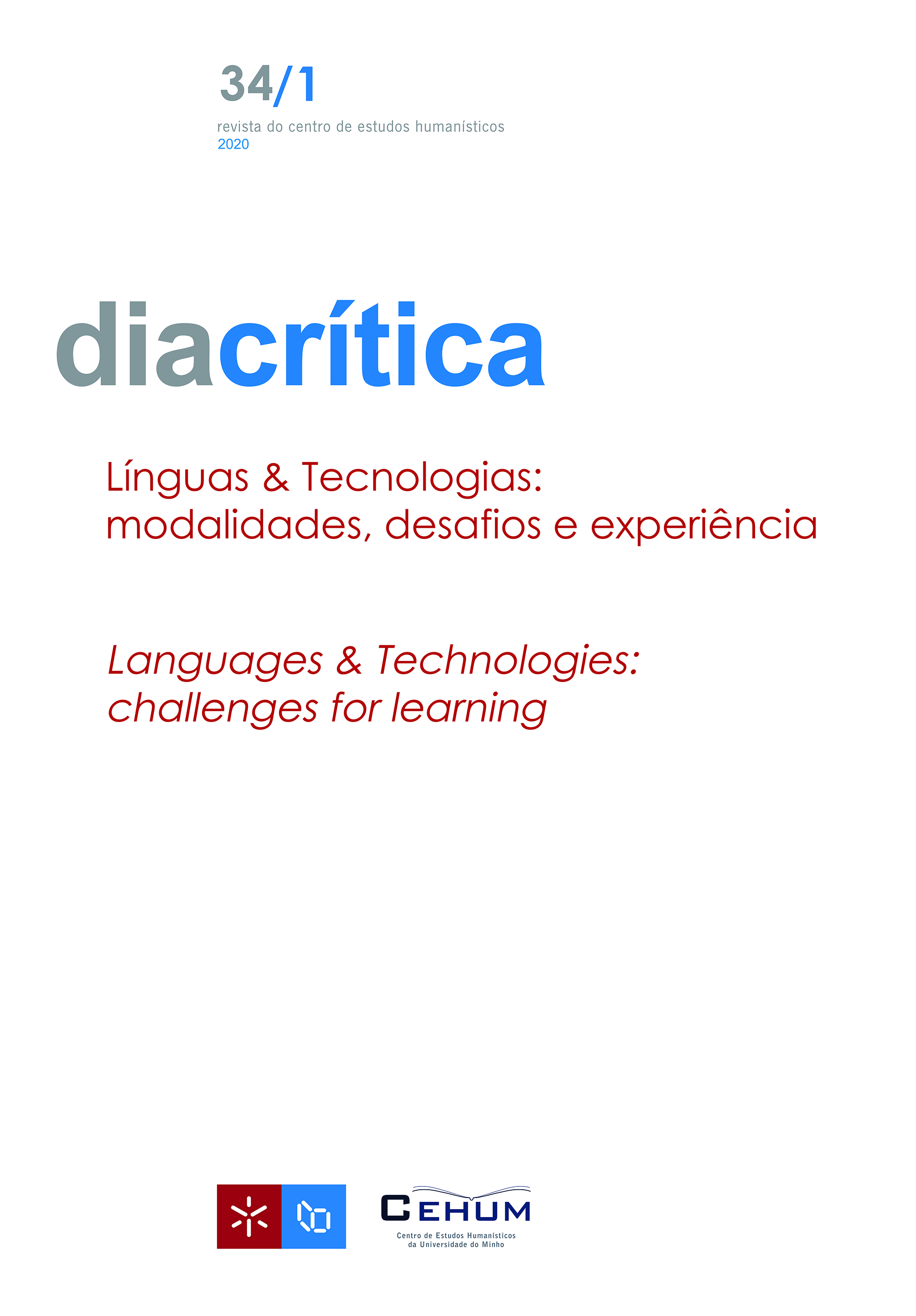Instrução de vocabulário em L2: Uma análise de aplicativos para a aprendizagem de inglês
DOI:
https://doi.org/10.21814/diacritica.4970Palavras-chave:
Instrução de vocabulário, Aprendizagem móvel, Aprendizagem de segunda língua, Aplicativos de smartphoneResumo
A popularização dos smartphones nas últimas décadas promoveu o desenvolvimento de diversos aplicativos para o aprendizado de línguas e fomentou o interesse no campo da aprendizagem móvel. Considerando que boa parte dos aplicativos de smartphone para a aprendizagem de inglês tem atividades para a instrução de vocabulário, este estudo buscou analisar o desenvolvimento de vocabulário nos três aplicativos para a aprendizagem de línguas mais utilizados até o final do ano de 2018. Mais especificamente, buscou-se compreender: a) quais aspectos do conhecimento de palavras os aplicativos desenvolvem; b) se existem múltiplos encontros com as palavras-alvo e se esses encontros são espaçados; e c) as representações não-verbais utilizadas pelos aplicativos. Os resultados indicam que os aplicativos: a) instruem a forma oral e escrita das palavras, porém negligenciam outros aspectos do conhecimento de palavras; b) provem, com o auxílio de algoritmos, múltiplos encontros espaçados com as palavras-alvo; e c) utilizam imagens e vídeos que nem sempre são relevantes para a instrução das palavras-alvo. Com base nos resultados deste estudo, entendemos que os aplicativos podem auxiliar o desenvolvimento de vocabulário de língua inglesa, apesar de limitações como a falta de oportunidades para a produção de linguagem e o ensino descontextualizado.
Referências
Attewell, J. & Savill-Smith, C. (2003). M-learning and social inclusion – focusing on learners and learning. Proceedings of MLEARN 2003: Learning with Mobile Devices, 3–12. London: Learning and Skills Development Agency.
Andrade, I. R. (2017). Aprendizagem de língua assistida por Dispositivos móveis (ALADIM): uma proposta alternativa para o ensino da língua espanhola (Unpublished PhD thesis, Unicamp, Campinas, Brasil).
Bahrick, H. P. & Phelps, E. (1987). Retention of Spanish vocabulary over 8 years. Journal of Experimental Psychology: Learning, Memory and Cognition, 4, 316–321. DOI: https://doi.org/10.1037/0278-7393.13.2.344
Bloom, K. C. & Shuell, T. J. (1981). Effects of massed and distributed practice on the learning and retention of second-language vocabulary. Journal of Educational Research. 74, 245–248. DOI: https://doi.org/10.1080/00220671.1981.10885317
BuzzFeedPress. (2017). BuzzFeed expands internationally in partnership with Duolingo. <https://www.buzzfeed.com/buzzfeedpress/buzzfeed-expands-internationally-in-partnership-with-duoling?utm_term=.koE4Kq0Z#.eoXw6nk8>. Consulted on: 6th Mar. 2017.
Carter, R. (2012). Vocabulary: applied linguistic perspectives. Abingdon, Oxon: Routledge. DOI: https://doi.org/10.4324/9780203124659
Chapelle, C. & Jamieson, J. (2008). Tips for teaching with CALL: Practical approaches to computer-assisted language learning. New York: Pearson Education.
Chinnery, G. M. (2006). Going to the mall: mobile assisted language learning. Language Learning & Technology, 10, 9–16.
Clark, J. & Paivio, A. (1991). Dual Coding Theory and Education. Educational Psychology Review, 3 (3), 149–210. DOI: https://doi.org/10.1007/BF01320076
Garcia, I. (2013). Learning a language for free while translating the Web. Does Duoliongo work? International Journal of English Linguistics, 3, 19–25. DOI: https://doi.org/10.5539/ijel.v3n1p19
Goossens, N., Camp, G., Verkoeijen, P., Tabbers, H. & Zwaan, R. (2012). Spreading the words: A spacing effect in vocabulary learning. Journal of Cognitive Psychology, 24. 965-971. DOI: https://doi.org/10.1080/20445911.2012.722617
Hatch, E. & Brown, C. (1995). Vocabulary, Semantics and Language Education. New York: Cambridge University Press.
Kim, H. & Kwon, Y. (2012). Exploring smartphone applications for effective mobile-assisted language learning. Multimedia-Assisted Language Learning, 15 (1), 31–57. DOI: https://doi.org/10.15702/mall.2012.15.1.31
Laufer, B. (1997). What's in a word that makes it hard or easy: some intralexical factors that affect the learning of words. In N. Schmidtt & M. McCarthy (Eds.), Vocabulary Description, Acquisition and Pedagogy (pp. 154–160). Cambridge: Cambridge University Press.
Laufer, B. (2017). The Three ‘I’s of second language vocabulary learning: Input, instruction, involvement. In E. Hinkel (Ed.), Handbook of research in second language teaching and learning, 3, (pp. 343–354). London: Routledge. DOI: https://doi.org/10.4324/9781315716893-25
Levy, M. (1997). Computer-assisted language learning: context and contextualization. Oxford: Oxford University Press.
Lewis, M. (1993). The lexical approach. Hove and London: Language teaching publications.
Mayer, R. (2009). Multimedia Learning. New York: Cambridge University Press. DOI: https://doi.org/10.1017/CBO9780511811678
Meara, P. (1980). Vocabulary acquisition: A neglected aspect of language learning. Language Teaching and Linguistics Abstracts, 13, 221–246. DOI: https://doi.org/10.1017/S0261444800008879
Naismith, L. (2004). Literature review in mobile technologies and learning. Bristol: Nesta Futurelab.
Nation, I. S. P. (1990). Teaching and learning vocabulary. Boston: Heinle & Heinle Publishers.
Nation, I. (2001). Learning Vocabulary in Another Language. Cambridge: Cambridge University Press. DOI: https://doi.org/10.1017/CBO9781139524759
Sadoski, M. (2005). A Dual Coding View of Vocabulary Learning. Reading & Writing Quarterly: Overcoming Learning Difficulties, 21, 221–238. <http://dx.doi.org/10.1080/10573560590949359>. Consulted on: 16th Dec. 2018. DOI: https://doi.org/10.1080/10573560590949359
Settles, B. & Meeder, B. (2016). A Trainable Spaced Repetition Model for Language Learning. Proceedings of the 54th Annual Meeting of the Association for Computational Linguistics. 1848–1858. DOI: https://doi.org/10.18653/v1/P16-1174
Schmitt, N. (2000). Vocabulary in language teaching. Cambridge: Cambridge University Press
Sökmen, A. J. (1997). Current trends in teaching second language vocabulary. In N. Schimitt & M. McCarthy (Eds.), Vocabulary: Description, Acquisition and Pedagogy (pp. 237–257). Cambridge: Cambridge University Press.
Stimac, B. (2014). Google Play Store now showcases app download numbers with new badges. <https://www.greenbot.com/article/2463910/google-play-store-now-showcases-app-download-numbers-with-new-badges.html>. Consulted on: 22nd Nov. 2018.
Stockwell, G. (2010). Using mobile phones for vocabulary activities: examining the effect of the platform. Language Learning & Technology, 14, 95–110.
Stockwell, G. & Hubbard, P. (2013). Some emerging principles for mobile-assisted language learning. The International Research Foundation for English Language Education. <http://www.tirfonline.org/english-in-the-workforce/mobile-assisted-language-learning>. Consulted on: 22nd Nov. 2018.
Ullman, M. & Lovelett, J. T. (2016). Implications of the declarative/procedural model for improving second language learning: The role of memory enhancement techniques. Second language research, 1, 1–27. DOI: https://doi.org/10.1177/0267658316675195
Vesselinov, R. & Grego, J. (2012). Duolingo effectiveness study. <http://comparelanguageapps.com/documentation/DuolingoReport_Final.pdf>. Consulted on: 15th Dec. 2018.
Vekiri, I. (2002). What Is the Value of Graphical Displays in Learning? Educational Psychology Review, 14 (3), 261–312. DOI: https://doi.org/10.1023/A:1016064429161
Downloads
Publicado
Como Citar
Edição
Secção
Licença
Direitos de Autor (c) 2023 Daniel Reschke Pires, Celso Henrique Soufen Tumolo

Este trabalho encontra-se publicado com a Creative Commons Atribuição-NãoComercial 4.0.










